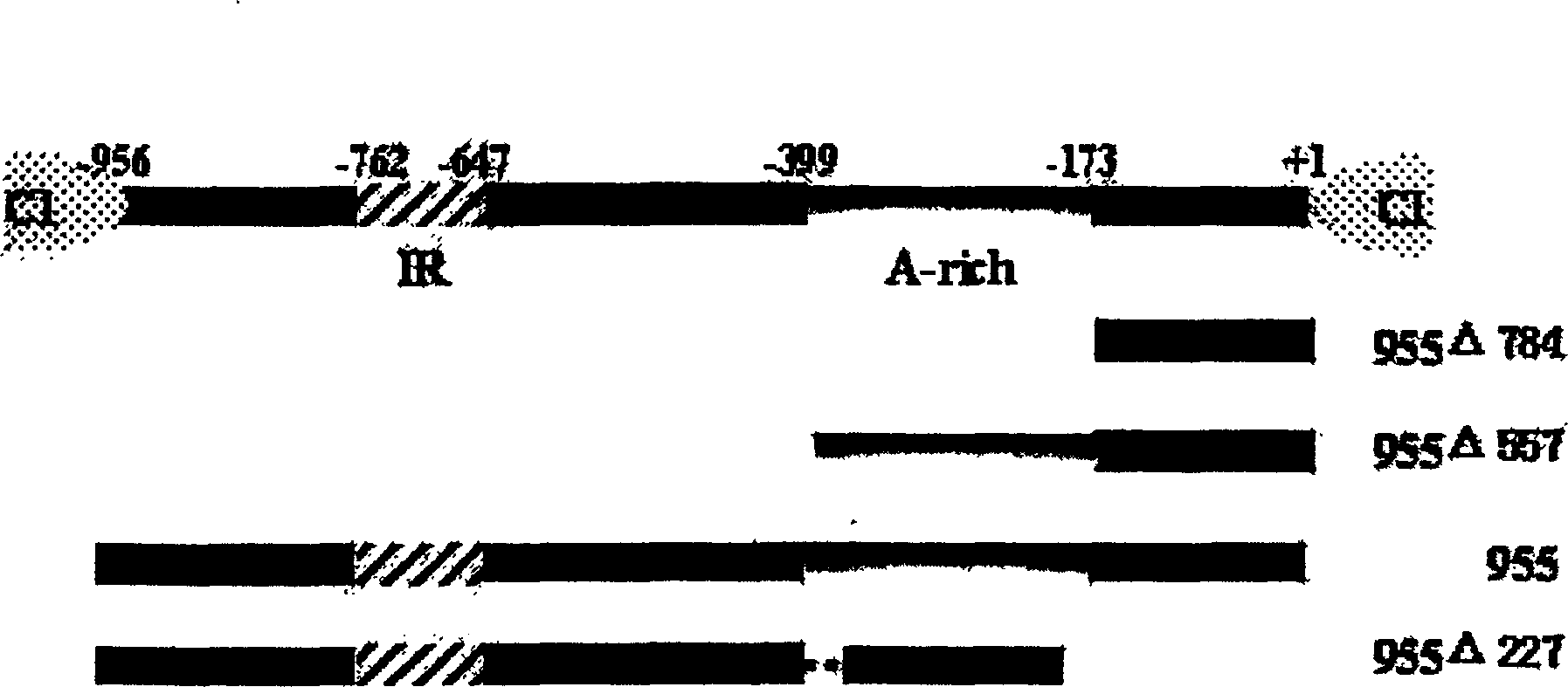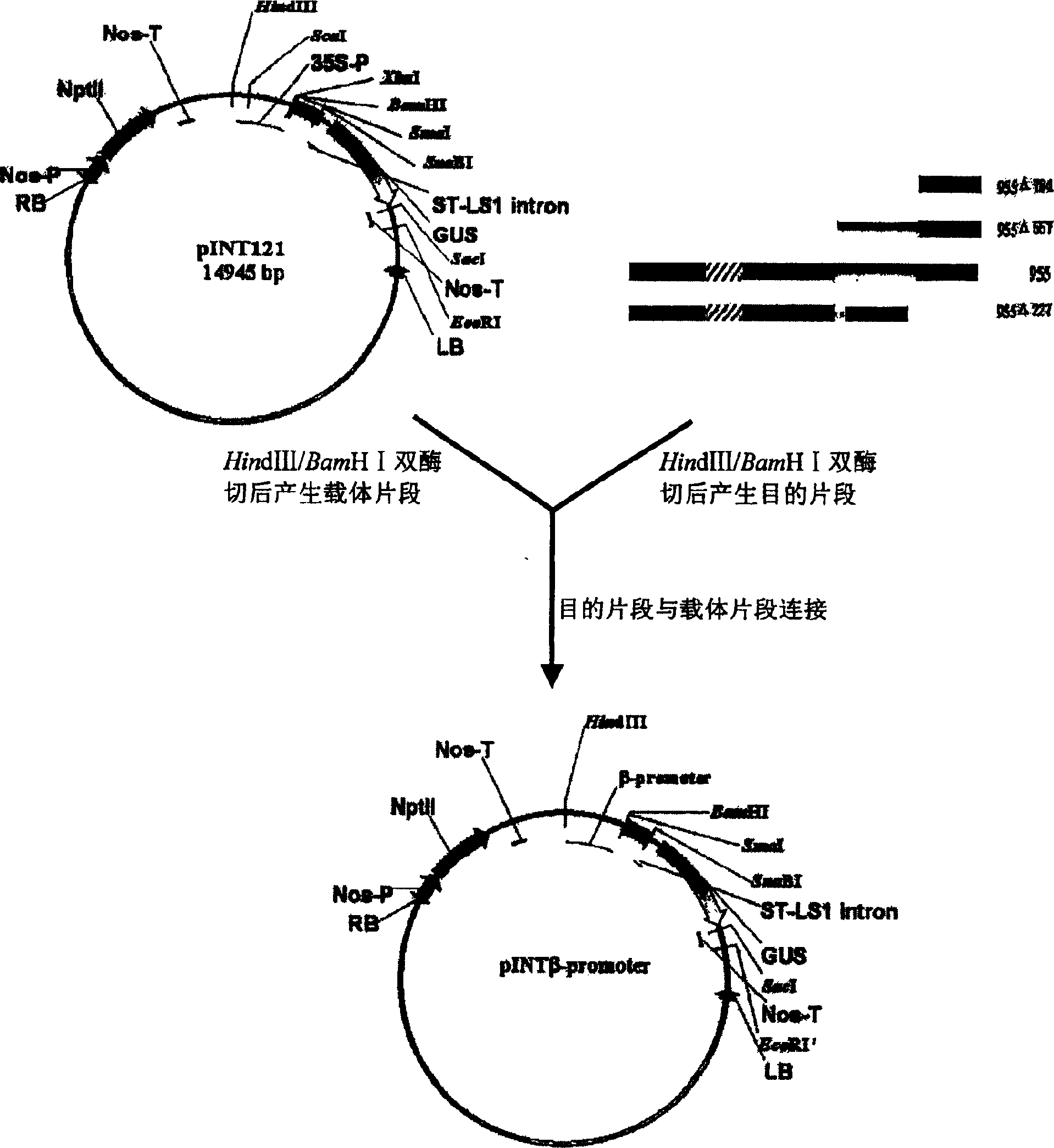Phloem specific expressing promoter
A promoter and gene technology, applied in the field of transient expression and stable expression, to achieve high-efficiency, economical disease resistance, and elimination of gene silencing
- Summary
- Abstract
- Description
- Claims
- Application Information
AI Technical Summary
Problems solved by technology
Method used
Image
Examples
Embodiment 1
[0053] Example 1 Construction of full-length promoter and deletion promoter
[0054] Molecular techniques were performed essentially as described by Sambrook et al. (Molecular Cloning: A Laboratory Manual. Cold Spring Harbor Laboratory Press, Cold Spring Harbor Laboratory, NY, 1989).
[0055] Cloning and Sequencing of βC1 ORF Promoter Fragment of Chinese Tomato Yellow Leaf Curl Virus DNAβ
[0056] Tobacco leaves infected with Chinese tomato yellow leaf curl virus were used as materials, and the total plant DNA was extracted by CTAB method [Murray MG et al., 1987, EMBO J, 6: 3901-3907]. See the pre-amplified promoter fragments figure 1 . Using the total plant DNA as a template, each promoter fragment of the βC1 ORF of Chinese tomato yellow leaf curl virus DNAβ was amplified by specific primers. Primers FL (5'CCGAAGCTTTACATATATACG3', corresponding to positions 1-14 in SEQ ID NO1, introduced a HindIII site) and RL (5'AATGGATCCTGAGTCTGTTCTG3', corresponding to positions 955-94...
Embodiment 2
[0057] Example 2 Construction of GUS fusion expression vector
[0058] The binary expression vector pINT121 (the vector was donated by Fang Rongxiang, academician of the Institute of Microbiology, Chinese Academy of Sciences) was digested with restriction enzymes HindIII and BamHI, and the full-length promoter and various deleted promoter fragments were inserted into this site to construct a promoter Expression vector( figure 2 ): pINT-FL for full length promoter construct, pINTΔ784 for promoter 955Δ784 deletion, pINTΔ557 for promoter 955Δ557 deletion, pINTΔ227 for promoter 955Δ227 deletion construct.
[0059] The expression vector pINT121 was double digested with BamHI and EcoR I, and the digested GUS-NOS fragment was inserted into the BamHI / EcoR I site of the expression vector pBINPLUS. The constructed vector was pBINGUS, which was used as a negative control, and the vector pINT121 was used as a positive control ( image 3 ).
Embodiment 3
[0060] Example 3 Agrobacterium Transformation
[0061]The promoter constructs were introduced into Agrobacterium host cells by three-parent mating method [Wang Guanlin, Principles and Technology of Plant Genetic Engineering. Beijing: Science Education Press, 1998]. The specific method is as follows: the constructed promoter expression vector needs to be mediated by the helper plasmid pRK2013 to enter Agrobacterium EHA105. The constructed promoter expression vector was inoculated with 5 ml of LB liquid medium containing Km (50 μg / ml), and cultivated overnight at 200 rpm at 37°C; EHA105 was inoculated with 5 ml of Sm (50 μg / ml) YEP liquid medium, and cultivated at 200 rpm at 28°C for 48 Hours; the helper plasmid pRK2013 was inoculated with 5 ml of LB liquid medium containing Km (50 μg / ml), and cultivated overnight at 200 rpm at 37°C. Take 400μl of each of the three bacterial solutions, mix them upside down, collect the bacterial solution at 6000rpm for 30 seconds, and wash the ...
PUM
 Login to View More
Login to View More Abstract
Description
Claims
Application Information
 Login to View More
Login to View More - R&D
- Intellectual Property
- Life Sciences
- Materials
- Tech Scout
- Unparalleled Data Quality
- Higher Quality Content
- 60% Fewer Hallucinations
Browse by: Latest US Patents, China's latest patents, Technical Efficacy Thesaurus, Application Domain, Technology Topic, Popular Technical Reports.
© 2025 PatSnap. All rights reserved.Legal|Privacy policy|Modern Slavery Act Transparency Statement|Sitemap|About US| Contact US: help@patsnap.com



